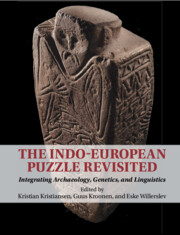Book contents
- The Indo-European Puzzle Revisited
- The Indo-European Puzzle Revisited
- Copyright page
- Contents
- Figures
- Tables
- Contributors
- Preface
- Introduction
- Part I Early Indo-European and the Origin of Pastoralism
- Part II Migratory Processes and Linguistic Dispersals between Yamnaya and the Corded Ware
- Part III The Cultural and Linguistic Significance of Bell Beakers along the Atlantic Fringe
- Part IV The Bronze Age Chariot and Wool Horizons
- 14 Relative and Absolute Chronologies of the Chariot Complex in Northern Eurasia and Early Indo-European Migrations
- 15 Indo-European and Indo-Iranian Wagon Terminology and the Date of the Indo-Iranian Split
- 16 Fire and Water: The Bronze Age of the Southern Urals and the Rigveda
- 17 Wool Fibers of the Northern Eurasian Bronze Age: The Cultural and Geographical Contexts
- 18 An Archaeolinguistic Approach to Indo-European Wool Terminology
- Part V Kinship Systems, Marriage, Fosterage, Free, and Unfree
- Concluding Reflections
- Index
- References
18 - An Archaeolinguistic Approach to Indo-European Wool Terminology
from Part IV - The Bronze Age Chariot and Wool Horizons
Published online by Cambridge University Press: 29 April 2023
- The Indo-European Puzzle Revisited
- The Indo-European Puzzle Revisited
- Copyright page
- Contents
- Figures
- Tables
- Contributors
- Preface
- Introduction
- Part I Early Indo-European and the Origin of Pastoralism
- Part II Migratory Processes and Linguistic Dispersals between Yamnaya and the Corded Ware
- Part III The Cultural and Linguistic Significance of Bell Beakers along the Atlantic Fringe
- Part IV The Bronze Age Chariot and Wool Horizons
- 14 Relative and Absolute Chronologies of the Chariot Complex in Northern Eurasia and Early Indo-European Migrations
- 15 Indo-European and Indo-Iranian Wagon Terminology and the Date of the Indo-Iranian Split
- 16 Fire and Water: The Bronze Age of the Southern Urals and the Rigveda
- 17 Wool Fibers of the Northern Eurasian Bronze Age: The Cultural and Geographical Contexts
- 18 An Archaeolinguistic Approach to Indo-European Wool Terminology
- Part V Kinship Systems, Marriage, Fosterage, Free, and Unfree
- Concluding Reflections
- Index
- References
Summary
As I have already discussed the field of Indo-European textile vocabulary on various occasions,1 I will here concentrate on the etymological status and time horizon of the word for ‘wool’. By way of introduction, it will suffice just to recapitulate a few main points.
- Type
- Chapter
- Information
- The Indo-European Puzzle RevisitedIntegrating Archaeology, Genetics, and Linguistics, pp. 282 - 286Publisher: Cambridge University PressPrint publication year: 2023



